Written by: Shahida JJ - Posted on: June 12, 2014 |  Comments
Comments
Google Translation: اُردو | 中文
We paid a visit to the Filoli, a country house set in 16 acres (6.5 ha) of formal gardens surrounded by 654 acres (265 ha) estate, located in Woodside, California, about 25 miles (40 km) south of San Francisco, at the southern end of Crystal Springs Lake, on the eastern slope of the Santa Cruz Mountains.
You reach it through a long private road off the Freeway - with a check post, and a big parking area packed with vehicles of visitors. The walk way leading to the reception and ticket building was through a large olive grove. Its very tall trees created a tunnel-like canopy. Very old, majestic Oak trees were everywhere. After purchasing entrance tickets, we walked to the Mansion - the air was fragrant with flowers and enormous Magnolia trees were loaded with pink blooms. Volunteers, young and old were available to provide guided tours.
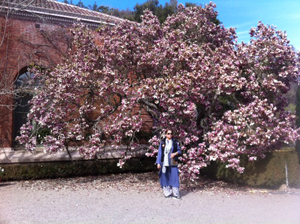 |
The author next to the Magnolia tree |
Filoli has served as the set for many Hollywood films. Most famously, it is the mansion seen from the air in the opening credits of the US television series Dynasty, which aired from 1981 to 1989. Dynasty was ranked the Number One Show in the USA in spring of 1985. The mansion’s plush interiors were featured in the first episodes of the series but were subsequently replicated on sound stages at the Fox Studios, Century City.
Filoli was also seen in the Hollywood movie, Heaven Can Wait.
Now owned by the National Trust for Historic Preservation, Filoli is open to the public. The site is both a California Historical Landmark and listed on the National Register.
Filoli closes its doors for the winter months, when it is rainy and cold. It was open for visitors February 11, 2014.
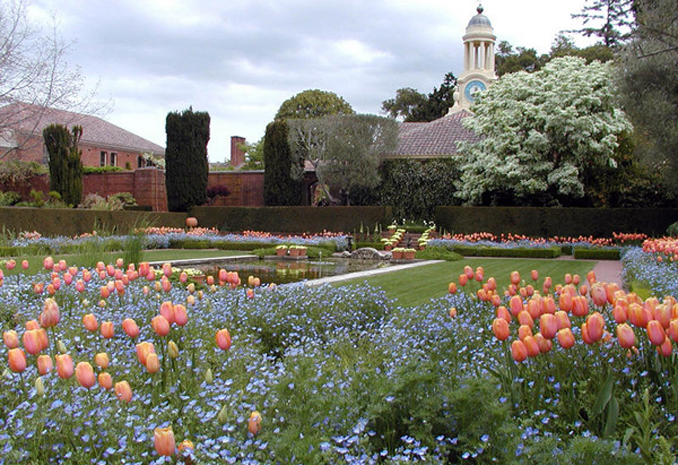 |
The Filoli gardens |
Background
The first quarter of the twentieth century was a time of incredible growth and wealth in California. Many estates were created on the peninsula south of San Francisco both before and after the 1906 earthquake. William Bowers Bourn, owner of the Empire Gold Mine, hired the prominent architect Willis Polk to design Filoli as his retirement estate from 1915-1917.
Filoli served as one of the Bourns' residences from 1917 to 1936. The name of the estate is an acronym formed by combining the first two letters from the key words of William Bourn's credo: "Fight for a just cause; Love your fellow man; Live a good life."
Key details
The house is 36,000 square feet containing 43 rooms, 17 bathrooms, 17 fireplaces and 18 ft. high ceilings on the first floor. The servants’ quarters originally consisted of twelve bedrooms and six bathrooms. Two diesel boilers heated the house. The Mansions exterior walls are 4 ft. thick.
Reception Room
The Reception Room served as the main meeting area to welcome guests to the estate. Among the furnishings of the room is a white Carrara marble fireplace inlaid with red Verona marble in a Greek key motif, a Chinese, palace-sized, Coromandel screen, and an antique Persian carpet with Persian lettering.
Dining Room
The baronial, oak-paneled dining room includes a French Escalette marble fireplace, original draperies, and a 1703 oil painting by Jan Weenix titled, Still Life with Dead Game.
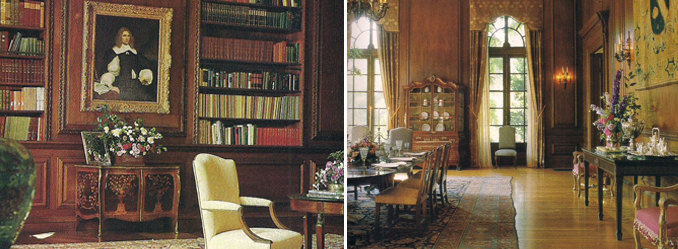 |
The library (L) and the Dining Room |
Furniture
The 17th and 18th century antiques throughout the house are primarily English and Irish in origin.
Bourn and Roth his wife's Portraits, Paintings, and Tapestries
The house contains a collection of English and European paintings and tapestries from the 17th and 18th century, as well as detailed oil paintings, charcoal representations, and black and white photographic collections of both the Bourn and Roth families.
Library
Stately in nature, this room contains 19th century Italian Renaissance-styled bronze chandeliers and sconces, a Tavernelle marble fireplace, furniture from the 17th and 18th century, and a sizable Agra carpet which was originally in Osborne House, Queen Victoria's home on the Isle of Wight. The floor is oak.
The Tiffany silver (originally belonging the Bourns) includes more than 500 pieces, most are displayed in the show cases, and on tables in the Dining area, polished, glowing and shiny.
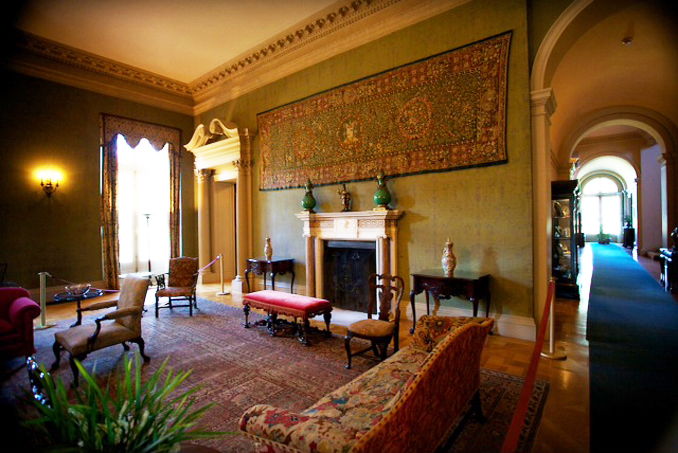 |
The formal drawing room |
Following the deaths of William and Agnes Bourn in 1936, the estate was sold the following year to Mr. and Mrs. William P. Roth. Mrs. Roth was Lurline Matson, heir of the Matson Navigation Company.
Only a few of the furnishings are original to the Bourns, such as the tapestry above the fireplace. Others were part of the Roths' collection (the 2nd and last private owners of the estate who gifted it in 1975 to the National Trust), but primarily the furnishings at present were only put into place 10 years ago by a very generous collector, Melvin Martin.
The Roth family built Filoli's botanic collections of camellias, rhododendrons and azaleas, notably in the woodland garden, and added the serene swimming pool and the screened-in teahouse. The horticulturist who designed the plantings and fixed the original color schemes was Isabella Worn; she supervised the garden's maintenance for 35 years.
In 1975, Mrs. Roth donated the estate in its entirety to the National Trust for Historic Preservation, with an endowment that helps support annual operating expenses. The estate operates as Filoli Center, a private, non-profit organization with its own Board of Governors, staff and volunteers.
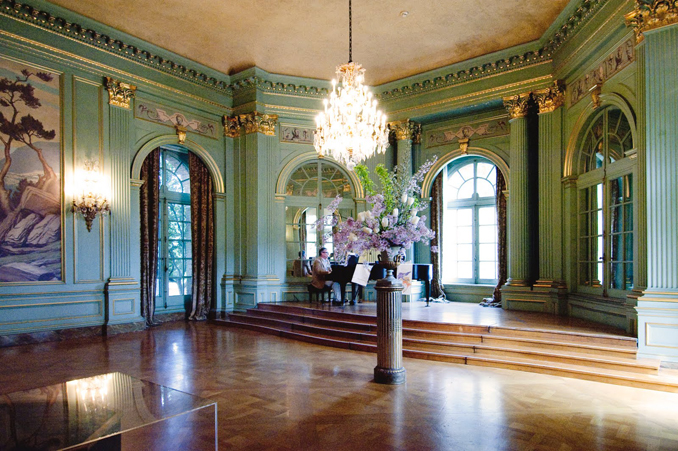 |
The ballroom |
After it was acquired by the National Trust for Historic Preservation in 1975, Filoli has been open for public tours.
School children take field trips to Filoli and hike the mountains.
Over 100,000 people visit Filoli each year, and there is an entrance fee.
The Friends of Filoli organization is comprised of over 1,200 dedicated volunteers, which is governed by the Board of Directors of the Filoli Center.
This popular Filoli tradition is perfect for meeting friends or small group events. Afternoon Tea takes place the fourth Wednesday of each month, February through October and April 9. Seating is limited. Reservations are required. The menu changes monthly and is a fixed one that includes assorted tea sandwiches, mini-pastries and other seasonal delectables.
Seating begins at 1:00 pm and teas take place on the following 2014 dates: February 26, March 26, April 9, April 23, May 28, June 25, July 23, August 27, September 24, October 22.
This was the situation when we visited Falioli:
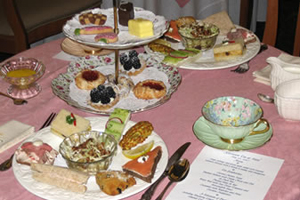 |
Afternoon tea at the garden cafe |
"Price: $50 members; $60 non–members and includes general admission to the House and Garden.
"Special October 22 Tea is $65 members; $75 non–members..
Experience this lovely tradition in the relaxing and gracious ambiance of Filoli. Enjoy delicious sandwiches, seasonal salads, scones with fresh lemon curd and pastries presented on linen tablecloths. Tea is served in our beautiful collection of china teacups, donated through the years by Filoli members and volunteers".
We had our tea at the Cafe.
What a beautiful preserve!